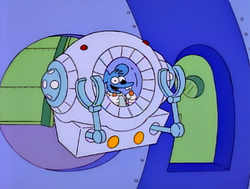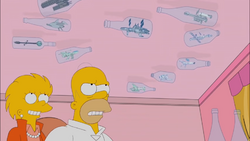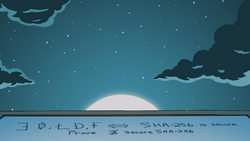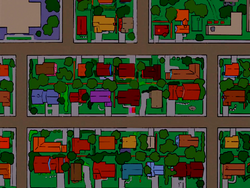|
|
| Line 86: |
Line 86: |
| | {{TB|''Also sprach Zarathustra'' plays when Homer begins to strangle Bart.}} | | {{TB|''Also sprach Zarathustra'' plays when Homer begins to strangle Bart.}} |
| | {{TBT|[[File:THOH XXVII 2001.png|250px]]}} | | {{TBT|[[File:THOH XXVII 2001.png|250px]]}} |
| − | {{TB|[[Season 28|28]]}} | + | {{TRs|[[Season 28|28]]|2}} |
| | {{TB|600}} | | {{TB|600}} |
| | {{TB|"[[Treehouse of Horror XXVII]]"}} | | {{TB|"[[Treehouse of Horror XXVII]]"}} |
| | {{TB|[[Bill Odenkirk]] is credited as "2001: A Space Odenkirk".}} | | {{TB|[[Bill Odenkirk]] is credited as "2001: A Space Odenkirk".}} |
| | + | {{TBT|[[File:2001 A Space Odyssey Dominoes Pizza.png|250px]]}} |
| | + | {{TB|610}} |
| | + | {{TB|"[[Fatzcarraldo]]"}} |
| | + | {{TB|The sun rising behind the [[Dominoes Pizza]] box is a parody of one of the monolith scenes.}} |
| | {{TBT|[[File:Bart's Not Dead 2001.png|250px]]}} | | {{TBT|[[File:Bart's Not Dead 2001.png|250px]]}} |
| | {{TRs|[[Season 30|30]]|2}} | | {{TRs|[[Season 30|30]]|2}} |
Revision as of 15:07, March 26, 2021
2001: A Space Odyssey is a science fiction film produced and directed by Stanley Kubrick, released in 1968. The novel of the same title, by Arthur C. Clarke, was written concurrently with the development of the film and was published after the film's release. A sequel to the novel, titled 2010: Odyssey Two, appeared in 1982 and was adapted into a film in 1984. Clarke went on to write two additional sequels in the 2001 series, 2061: Odyssey Three and 3001: The Final Odyssey, neither of which has been adapted into a movie.
The film tells the story of the spaceship Discovery One, which is en route to Jupiter ostensibly on a scientific mission. The main characters are astronaut David Bowman and HAL 9000, the ship's computer. The mission's true purpose (unbeknownst to Bowman but known to HAL) is to investigate the intelligence behind a mysterious black monolith that sent a radio signal to the outer reaches of the solar system and also (as shown in the film) influenced humanity's pre-history. HAL malfunctions due to the mission's need for secrecy being incompatible with his programming, and Bowman is forced to deactivate him. Bowman reaches Jupiter, discovers another monolith in orbit about the planet, and leaves the ship in an EVA pod. When Bowman approaches the monolith, he inadvertently activates a stargate which sends him across vast distances of space. In the end, Bowman unites with the alien intelligence behind the monoliths and becomes a fetus-like Star Child which is seen floating in space near Earth in the movie's final scene.
2001: A Space Odyssey did very well at the box office and was the highest-grossing film in North America in 1968. It has since been regarded as a landmark in the sci-fi genre and one of the most influential movies of all time. Among other things, it was noted for its then ground-breaking special and visual effects, scientifically accurate depiction of space travel, and use of classical music in the score. Two of the best-known musical themes from the film are "The Blue Danube", which is the waltz heard when the "space plane" docks with the space station; and Also sprach Zarathustra, the fanfare heard during the film's opening and closing scenes. Also sprach Zarathustra has achieved iconic status in popular culture and become the de facto theme of 2001.
2001: A Space Odyssey has been referred to several times in Simpsons media.
References to 2001: A Space Odyssey in The Simpsons
Episodes
| Picture
|
Season
|
Episode number
|
Episode name
|
Reference
|

|
3
|
43
|
"Lisa's Pony"
|
At the beginning of the episode, Homer dreams he is one of the apes in the "Dawn of Man" sequence. While the other apes learn to use fire and tools, Homer uses the monolith as a back-scratcher and falls asleep leaning against it.
|

|
59
|
"Brother, Can You Spare Two Dimes?"
|
Homer's vision when he rides the Spinemelter 2000 is based on the "Star Gate" sequence.
|




|
5
|
96
|
"Deep Space Homer"
|
In the Itchy & Scratchy episode, Itchy leaves the ship to retrieve Scratchy, flying an EVA pod which resembles the ones on Discovery.
In the scene where Homer eats the floating chips, the background music is "Blue Danube", which is heard during the docking scene in 2001. Also, the closeup where Homer opens his mouth as he approaches a chip is a visual callback to the docking scene.
Also Sprach Zarathustra plays during the episode's ending scene. Bart throwing the marker pen which turns into a satellite references the transition from the Dawn of Man sequence to the space station. The satellite hits an embryonic Homer, who appears as a Star Child in orbit about Earth.
|

|
10
|
220
|
"Maximum Homerdrive"
|
The Navitron Autodrive System says "I'm afraid I can't let you do this, Red", referencing the famous line from HAL 9000. It also uses a red light similar to HAL.
|



|
13
|
270
|
"Treehouse of Horror XII"
|
The "House of Whacks" segment has a number of references to 2001:
The Ultrahouse 3000 is based on HAL.
Marge and Homer's bedroom resembles the bedroom seen at the end of the film.
When Marge tries to escape, the Ultrahouse suggests that she take a stress pill. HAL makes the same suggestion to David Bowman.
Homer removes the circuit boards of the Ultrahouse to deactivate it, the same way that Bowman deactivates HAL. Also like HAL, as the circuit boards are removed, the Ultrahouse's voice becomes garbled and dies out completely when Homer removes the last one.
|

|
289
|
"Little Girl in the Big Ten"
|
Also sprach Zarathustra plays as Bart rolls Lisa (enclosed in the plastic bubble) off of the school roof to land on the giant chocolate cake commemorating Principal Skinner's years of service.
|

|
15
|
330
|
"My Big Fat Geek Wedding"
|
In one shot, when the family is at the Bi-Mon-Sci-Fi-Con, a poster for the film can be seen at the top right of the screen (see image).
|

|
19
|
409
|
"Eternal Moonshine of the Simpson Mind"
|
Homer's vision of memories resembles the Star Gate.
|

|
22
|
485
|
"500 Keys"
|
After Lisa finds the hidden classroom at Springfield Elementary School, she notices that the things in it look real but don't really work, such as a ruler without lines and a book with pull tabs that don't do anything, similar to the hotel room (as described in the novel) where Bowman ends up after he goes through the Star Gate.
|

|
23
|
495
|
"Holidays of Future Passed"
|
One of the ships in bottles that Homer has built is Discovery (farthest to the left, above Lisa's head).
|


|
26
|
556
|
"Treehouse of Horror XXV"
|
Homer attacks Sideshow Mel with a bone similar to how the apes used bones as weapons in the Dawn of Man sequence. Afterwards, he sees what appears to be a black monolith, but is actually an iPhone shown up close.
Stanley Kubrick throws a pen in the air in the same way that one of the apes throws a bone at the end of the Dawn of Man sequence.
|

|
571
|
"The Kids Are All Fight"
|
Also sprach Zarathustra plays when Homer begins to strangle Bart.
|

|
28
|
600
|
"Treehouse of Horror XXVII"
|
Bill Odenkirk is credited as "2001: A Space Odenkirk".
|

|
610
|
"Fatzcarraldo"
|
The sun rising behind the Dominoes Pizza box is a parody of one of the monolith scenes.
|

|
30
|
640
|
"Bart's Not Dead"
|
The aliens seen at the beginning of the episode are in a room similar to the one seen at the end of the film.
|

|
643
|
"Treehouse of Horror XXIX"
|
When Lisa is absorbed by a pod, she has a vision based on the Star Gate sequence.
|

|
31
|
375
|
"Frinkcoin"
|
The sun rising over the whiteboard surrounded by lights in the town square is a reference to a scene from 2001: A Space Odyssey.
|
|
Specials
Video games
Other
Common cast and crew
Cast
External links





























